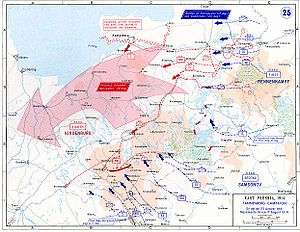Battle of Stallupönen
| Battle of Stallupönen | |||||||
|---|---|---|---|---|---|---|---|
| Part of the Eastern Front of World War I | |||||||
 Eastern Front, August 17–23, 1914. | |||||||
| |||||||
| Belligerents | |||||||
|
|
| ||||||
| Commanders and leaders | |||||||
|
|
| ||||||
| Strength | |||||||
| 1 infantry division - about 16,000 men[1] | 4 (25th, 27th, 29th, 40th) infantry divisions - about 84,000 men[2] | ||||||
| Casualties and losses | |||||||
| 1,297 casualties[3] |
619 killed, 2,382 wounded 4,466 captured Total 7,467[4] | ||||||
The Battle of Stallupönen, fought between Russian and German armies on August 17, 1914, was the opening battle of World War I on the Eastern Front. The Germans under the command of Hermann von François conducted a successful counterattack against four Russian infantry divisions from different infantry corps, which heavily outnumbered them but had poor coordination with each other[5] and created a gap between the 27th Infantry Division and the 40th Infantry Division.[6] It was a minor German success, but did little to upset the Russian timetable.
Prelude
The German Schlieffen Plan was based on defeating France (and the United Kingdom, should it be involved) as quickly as possible in the West, which would then permit the Germans to transport their forces eastward to meet the massive Russian Army. The Russians were able to field up to ten complete armies compared to Germany's eight, but they were scattered across the country and would take some time to organize and move up. This meant that the Germans had a short window of time where they could fight a defensive battle, holding off what forces the Russians could move forward, while they waited for the battles in the west to be decided.
Immediately prior to the opening of hostilities, the Eastern Front developed largely according to pre-war planning. Two Russian armies were in the immediate area, Pavel Rennenkampf's First Army east of the city of Königsberg, and Alexander Samsonov's Second Army to the south. Rennenkampf planned on marching on Königsberg, tying down any German forces in the area, while Samsonov would move northwest to cut off any escape.
The Germans were also deployed largely according to everyone's expectations. The German Eighth Army was strung out in pockets in front of Rennenkampf, but did not have the manpower to completely cover the front of either of the Russian armies. On paper, the situation looked almost hopeless, and the standing orders were to fight a delaying retreat. However, Hermann von François, the commander of the First Corps of the German Eighth Army, was convinced his better-trained and equipped forces could halt, and perhaps defeat, Rennenkampf's Russian forces.
Most of the Eighth Army was organized into a defensive line running south of Gumbinnen, about 20 miles (32 km) west of the Russian border. However, small units were sent forward to garrison towns, railway lines and strongpoints. They were ordered to retreat on contact with the enemy, joining the main forces at Gumbinnen. For the first five days of the war, the only combat was minor skirmishes with Rennenkampf's cavalry who were conducting reconnaissance along the border area.
The battle
On August 17, Rennenkampf started the invasion of East Prussia, marching the First Army directly westward towards the German lines. Although he faced no resistance, Rennenkampf stopped his advance in a neat line about five miles (8 km) from the border. Acting without orders, François decided to take his forces to Stallupönen where one of the Russian divisions was resting.[7] A furious frontal attack broke the Russian division, which fled eastward, losing 3,000 casualties and 5,000 prisoners, almost the entirety of the Russian 105th Regiment. Although the Russian 29th and 25th Divisions achieved some success to the north of Stallupönen and captured several captives and guns, they couldn't change the outcome of the battle.[6]
When Prittwitz learned that François had engaged the Russians, he ordered François to break off the attack and retreat to the Vistula.[7] François by this time was too committed to safely disengage, and had no intention of doing so anyway. He contemptuously, and famously, told the adjutant, "Report to General Prittwitz that General von François will withdraw when he has defeated the Russians."
Aftermath
While the Russians retreated, François pursued them into the evening, but ended his advance when he came under Russian artillery fire. He then reluctantly obeyed Prittwitz's order and withdrew 15 miles (24 km) to the west, taking up new positions around Gumbinnen. His success was infectious, and convinced Prittwitz to be more aggressive in dealing with the Russian forces. This proved to be unwise at the following Battle of Gumbinnen two days later.
References
- ↑ Reichsarchiv (Hrsg.), Die Befreiung Ostpreußens (Der Weltkrieg, Band 2), Berlin 1925, S. 76 sowie Anlage 2.
- ↑ Otto, Helmut, Schmiedel, Karl, Der erste Weltkrieg. Militärhistorischer Abriß, 3., völlig überarbeitete und ergänzte Auflage, Berlin 1977, S. 62.
- ↑ Tannenberg 1914, p. 18.
- ↑ Tannenberg 1914, Warszawa, 2005; p. 18.
- ↑ Buttar 2014, p. 120, 122.
- 1 2 Buttar 2014, p. 122.
- 1 2 Gilbert 1994, p. 48.
Sources
- Buttar, Prit (2014). Collision of Empires: the War on the Eastern Front in 1914. Osprey. ISBN 9781782006480. OCLC 858956311.
- Gilbert, Martin (1994). The First World War: A Complete History. New York: Henry Holt and Company. ISBN 080501540X.
External links
Coordinates: 54°37′50″N 22°34′24″E / 54.63056°N 22.57333°E